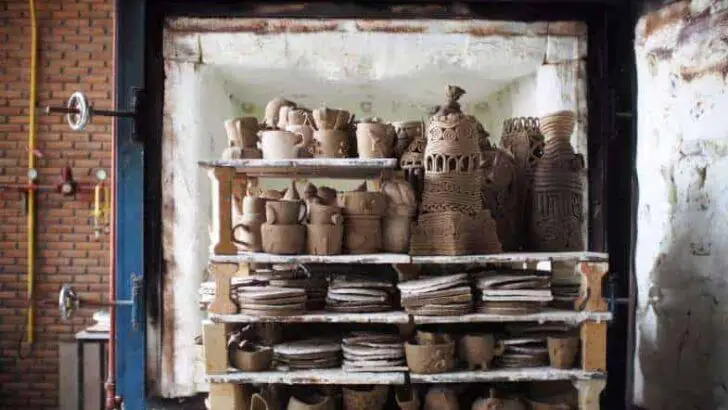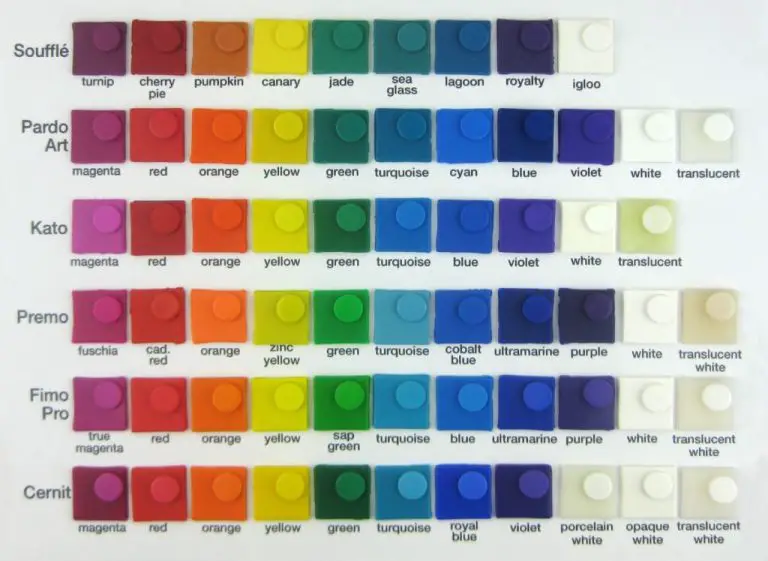How Do You Fire Clay?
The term firing refers to the process of heating clay to high temperatures in a kiln in order to harden and finish clay products. Firing is a critical step in transforming soft, porous clay into a hard, durable material that is water resistant and stable over time. Proper firing allows clay to reach its full strength and potential as a material for functional pottery, sculptures, tiles, and other applications.
The firing process typically involves slowly raising the temperature in the kiln over a period of several hours up to a peak temperature, which can range from about 1000°F to over 2300°F depending on the type of clay and desired results. At high temperatures, chemical changes occur in the clay that lead to vitrification, which fuses the silica particles and creates a glassy finish.
Firing is important because without this process, clay remains fragile, absorbs liquids easily, and deteriorates over time. Firing clay enables it to hold its shape without deforming, become impervious to water, and withstand repeated use. The firing process transforms soft clay into a hardened material that has durable, long-lasting qualities suitable for creative and practical purposes.
Preparing the Clay
Before firing, it’s important to properly prepare the clay to avoid defects and cracking. This preparation involves wedging or kneading the clay to remove air bubbles and achieve an even moisture content throughout.
Wedging involves cutting the clay into chunks, slamming it against the table, and reforming it into a ball shape. This process squeezes out trapped air bubbles and blends stiff and moist sections together. Kneading simply involves working the clay with your hands repeatedly. Both techniques ensure the clay has a uniform consistency.[1]
The right moisture content for firing is typically 5-10%. Clay straight from an air-tight bag often needs to be dried out somewhat. Test the clay by shaping a small piece into a ball. If it doesn’t crack as it dries, the moisture level is suitable. Let test pieces dry fully before firing.
It’s also a good idea to fire test tiles made from each new clay batch. Check for defects like cracking or incomplete fusion. If the test tiles fire successfully, you can proceed to firing the rest of the prepared clay pieces.
Drying the Clay
Proper drying of the clay before firing is a crucial step to avoid cracking and weakening of the final piece. Clay contains water which must be slowly released before firing. If clay is dried too quickly, such as placing wet clay in direct sunlight or near a heat source, uneven drying can cause stresses which lead to cracks as the clay shrinks. Slow, even drying is key.
There are several techniques to dry clay slowly and minimize cracking. Allowing clay to air dry naturally at room temperature is the most gradual. This may take several days or weeks depending on the size and thickness of the piece. Placing the clay in a shadow box that allows for air circulation while limiting direct light will also prevent uneven drying. A damp box lined with plastic or wet newspaper provides increased humidity to slow moisture loss. The piece can also be loosely wrapped in plastic while air drying to limit surface drying. Moving air with a fan will help circulate air without overly drying the surface. The key is even, gradual drying over days, not hours. Rushing the drying risks cracking in the final fired piece.
Once clay is fully dried, it is ready for firing. Check for cracks prior to firing, as these weak spots can expand in the kiln. Firing wet clay can also cause steam explosions. (Source)
Selecting a Kiln
When selecting a kiln for firing clay, you’ll need to decide between an electric or gas fired kiln. Electric kilns are more common for home use as they are simpler to operate and maintain. Gas kilns allow more control over the firing environment and can achieve higher temperatures, but require ventilation and more safety precautions.
Key factors to consider when selecting a kiln include:
- Size – Make sure to choose a kiln large enough for the types of pieces you want to fire. Small tabletop kilns are good for jewelry and small sculptures, while larger kilns allow firing of pots, bowls, and other large items.
- Temperature range – Consider the maximum temperature needed for your desired firing types (e.g. cone 6, cone 10). Most electric kilns reach cone 6 temperatures (around 2,200°F), while gas kilns can achieve cone 10 for stoneware firing.
- Number of zones – Multiple independently controlled temperature zones allow more precision in firing.
- Element type – Kilns may have exposed elements that emit radiant heat or elements embedded in the brick insulation.
- Ramp speed – Faster temperature ramps require more power but allow shorter firing times.
- Brand and warranty – Reputable brands like Skutt and Olympic offer good options. Check warranty coverage.
Choosing the right kiln for your needs and budget will ensure you can successfully fire your clay work. Be sure to review kiln specifications before purchasing. Sources like this overview can help compare different kiln models.
Loading the Kiln
Properly loading the kiln is a crucial step to ensure even and thorough firing. Pieces should be arranged to promote good airflow and heat circulation throughout the chamber. Make sure to leave at least 1/2″ of space between pieces to allow for expansion during firing. Kiln shelves, props, and stilts are essential for separating and supporting pieces.
Kiln shelves made of refractory materials allow for stacking pieces vertically within the kiln. These sturdy shelves withstand high temperatures and conduct heat. Carefully place shelves in the kiln, making sure they are level. Prop up taller pieces on stilts to raise them off the shelves, and use props like ovals or triangles to support overhanging parts and prevent sagging or slumping.
Strategically load pieces so that those requiring lower temperatures are towards the front where it’s cooler. Place pieces requiring higher temperatures towards the back near the burners. Heating elements should be visible between pieces to enable all sides to get fired evenly. Refer to the kiln manufacturer’s manual for any specific loading guidelines. Stay within the kiln’s load weight limits to prevent damage.
Sources: https://bigceramicstore.com/pages/info-ceramics-tips-tip48_load_fire_kilns_part1
Choosing a Firing Program
When firing clay, you’ll need to select an appropriate firing program depending on whether you are doing a bisque firing or glaze firing. Bisque firing refers to the initial firing of unfired clay before any glazes are applied. This step converts the clay from its soft, wet form into a hardened state ready for glazing. Glaze firing is the second firing after glazes have been applied, melting the glaze onto the bisqueware to create a glossy coating.
For bisque firing, a slow ramp up time of 150-200°F per hour is recommended to allow excess water in the clay to evaporate slowly and prevent cracking. The target temperature is around cone 04-06 or 1656-1828°F. A similar slow cooling cycle is ideal. For glaze firing, a faster ramp up of 250-350°F per hour can be used up to a higher target temperature that matches the glaze manufacturer’s specifications, usually between cone 6 and cone 10 (2212-2345°F). The ramp down rate can also be faster since the clay has been through one firing already.
Choosing the right firing program is critical to avoid under-fired or over-fired results. Consulting the recommendations from your clay and glaze manufacturers is advised. Programmable electric kilns make it easy to set customized ramp rates and target temperatures for the optimal program.
The Firing Process
Firing clay involves heating the clay pieces in a kiln through a process called bisque firing and then glaze firing. During bisque firing, the clay pieces are heated to around 1600-2100°F which causes physical and chemical changes to occur.

As the temperature rises, any remaining water evaporates from the clay in a process called dehydration. Next, quartz inversion occurs around 1063°F where quartz molecules in the clay realign themselves. As bisque firing progresses, organic material burns out around 1100°F. Around 1550°F, chemical water is driven off. Finally, at the peak temperature, the clay undergoes sintering where particles partially melt and fuse together, making the clay hard and permanent.
During glaze firing, a glaze coating is applied to the bisqueware clay pieces. The glazed pieces are fired again, this time to around 1600-2300°F. At these high temperatures, the glaze melts and fuses with the clay body beneath it through a process called vitrification. This makes the ware non-porous, hard, and glass-like.
Both bisque firing and glaze firing result in permanent physical and chemical changes that transform soft clay into a hardened, finished ceramic ware. The firing process is essential for creating pottery, tableware, sculptures, and other clay artworks.
Source: https://quizlet.com/677646646/ceramics-quiz-flash-cards/
Testing Doneness
There are three main ways to test when your clay pieces are fully fired and ready to be removed from the kiln: using pyrometric cones, monitoring the kiln’s temperature gauge, and looking for visual cues.
Pyrometric cones, also called pyrometric witnesses or firing cones, are small pyramid shaped indicators placed inside the kiln that melt at specific temperatures. As the kiln heats up during the firing process, the cone will slowly bend over. When the cone has fully tipped over and melted away, you know the clay has reached the desired temperature. It’s important to note that different types of clay require different cone ratings based on their maturation temperature. Using the properly rated cone is crucial for achieving optimal results. (source)
Most electric kilns come equipped with a thermocouple device to monitor the internal temperature. Keep an eye on the temperature gauge and when it hits the target temperature recommended for the type of clay you are firing, you will know the pieces are likely finished firing. Be aware that the thermocouple may not provide a completely precise reading of the internal temperature. Using a cone is the most reliable method.
There are also visual cues that can indicate the clay is fired through. Look for an overall vitrified surface and slight color change on the clay pieces. Tap them gently with a tool and they should have a ring of high pitch, indicating they are fully fired. Pieces may also pull away slightly from shelf edges or posts. Compare fired samples to run test strips to ensure even heating and completion of the firing process.
Unloading and Cooling
After the firing process is complete, it’s important to allow adequate time for the kiln and ceramic pieces to cool before unloading. Removing pieces too soon can expose them to thermal shock, potentially causing cracks or breakage. A general rule of thumb is to allow the kiln to cool naturally down to 150°F before opening the lid.
Once cooled, carefully unload each shelf one at a time while wearing heat-resistant gloves. Gently place pieces on a heatproof surface for further cooling. Avoid abrupt temperature changes by not setting hot pieces directly on cold metal or concrete floors.
The final stage after unloading is called annealing. This involves allowing pieces to cool gradually over several hours. Rapid cooling can create internal stresses. Allow at least 6-12 hours for annealing before touching or moving finished pieces.
Check each piece for any firing issues like under-firing, cracking, or glaze defects. Sort pieces into keepers and ones that may require a secondary firing. Properly annealed pieces will have a uniform color and feel cool to the touch when fully cooled. They are now ready for finishing processes like sanding or applying sealants if desired.
With careful handling and patience during unloading and cooling, you can reveal beautiful professionally fired results. Just remember – patience is key after the firing is complete. Let the kiln fully cool, then allow proper annealing time before unleashing your newly fired ceramic masterpieces.
Conclusion
In summary, firing is a crucial process in transforming clay into a finished ceramic product. When clay is fired at high temperatures, chemical and physical changes occur that cause the clay particles to bond together permanently. This process, called sintering, transforms the clay body into a strong, hard material.
Proper firing technique is essential for achieving the desired results. Factors such as temperature, heating rate, soak time, and cooling can significantly impact the characteristics of the finished ware. Careful control over the entire firing process enables potters to produce ceramic work with the properties they intend.
By understanding the changes clay undergoes during firing, ceramic artists can master this process and create beautiful, durable ceramic art and functional ware.


